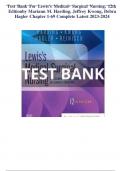Exam (elaborations)
TEST BANK For -Lewis Medical Surgical Nursing, 12th Edition by Mariann M. Harding , Verified Chapters 1 - 69, Complete Newest Version|complete guide | latest update2024|25.
Course
Lewis\\\\\\\\\\\\\\\'s Medical-Surgical Nursing 12th Ed
Institution
Lewis\\\\\\\\\\\\\\\'s Medical-Surgical Nursing 12th Ed
TEST BANK For -Lewis Medical Surgical Nursing, 12th Edition by Mariann M. Harding , Verified Chapters 1 - 69, Complete Newest Version|complete guide | latest update2024|25.TEST BANK For -Lewis Medical Surgical Nursing, 12th Edition by Mariann M. Harding , Verified Chapters 1 - 69, Complete Newest V...
[Show more]
Preview 4 out of 654 pages
Uploaded on
October 5, 2024
Number of pages
654
Written in
2024/2025
Type
Exam (elaborations)
Contains
Questions & answers
Institution
Lewis's Medical-Surgical Nursing 12th Ed
Course
Lewis's Medical-Surgical Nursing 12th Ed
$18.49
100% satisfaction guarantee
Immediately available after payment
Both online and in PDF
No strings attached
Test Bank For Lewis's Medical- Surgical Nursing, 12th




